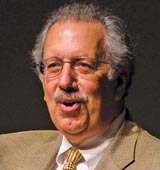|
Executive Interviews: Interview with Richard Boyatzis on The Making of a CEO
January 2009
-
By Dr. Nagendra V Chowdary
 Dr. Richard Boyatzis
Dr. Richard Boyatzis Professor in the Department of Organizational Behavior, Psychology and Cognitive Science at Case Western Reserve University and Human Resources at ESADE 
First, it was emotional intelligence
a decade ago and now it’s all about
social intelligence. Congratulations
to both of you (with your co-author,
Daniel Goleman) for making such
wonderful contributions to the field
of leadership. Can you tell us what
social intelligence is all about? What
does it entail for organizational leadership?
Studies of effective leaders and managers
throughout the world, including
in Turkey, have shown that more
effective ones use more competencies
thatwe nowcall social intelligence, as
well as those competencies we call
emotional intelligence and cognitive
intelligence.
|
|
The social intelligence
are those competencies, like Empathy
and Inspirational Leadership and
Teamwork that involve working with
others. These competencies involve
different neurological circuits and
hormones than do the EI and CI ones.
If organizations want to be effective,
the new leaders and managers should
use these competencies above the tipping
point. If they don’t have them,
their performance will suffer. They
may still make money (but that is not
hard in today’s world) but they will
not be effective over the long term, in
adapting and innovating in response
to competition.
-
Why do you think leadership always
attracted and continues to attract
researchers’, consultants’ and
organizations’ interest? What makes
it an ever-green field of study? What
does this continued interest suggest?
Because we were born to our parents,
we have unconscious fascination
with power and those who have it.
We are attracted to them, like our parents.
We also become suspicious of
them. So leadership is a love-hate relationship.
Also, because people in
power affect the lives of many others,
the study of leaders provides the possibility
of helping organizations and
societies become more humane and
effective with most leverage. On a
more prurient note, people pay money to read on leaders, studies of
leadership, and for speeches. So
there is also a pragmatic angle! One argument against such researches
is that they tend to preempt
any natural behavior and therefore
end up ‘boxing’ people. What is your
perspective therefore on the efficacy
of such research and what precautions
do you suggest should be taken
before generalizing few observations?
Adults can change. I have 20 years of
longitudinal studies showing that
adults can significantly improve on
their EI, SI, and CI competencies
within 1-2 years, and that these dramatic
changes hold for 7 years. So
how does this box people? I say the
opposite—there is liberation education.
We free people to become who
they dream of being, but using research
to guide the way. What is the difference between the
Emotional and Social Competency
Inventory and FIRO B exercise that
is popularly administered for similar
purposes?
They are two different tests. They test
different characteristics. They were
developed with different methods.
Are bananas and figs different? You have observed that social intelligence
turns out to be especially
important in crisis situations and
highlighted the chemistry of stress.
Why is it that social intelligence is of
paramount importance during crisis
situations?
People are cognitive hindering during
crisis. They do not know how to act
or think or even feel. They turn to
others for clues. Our mirror neurons
fire up and cause us to mimic their
emotions. Effective leaders manage
their own emotions and therefore
have a positive effect on the emotions
of others. Ineffective leaders do the
opposite and diminish people. It is 7 years since you (along with
your co-authors, Daniel Goleman
and Annie McKee) published the
path-breaking article, “Primal Leadership:
The Hidden Driver of Great
Performance” (HBR, December
2001). How did that research happen
and since then how was the momentum
for the research’s findings?
Have the recent events given new fillip
to the research’s underlying
ideas?
The research that went into Primal
Leadership (the book) started in 1970
and proceeded until 2001.
1.
CEO as Change Agent Case Study
2. ICMR
Case Collection
3.
Case Study Volumes
|
